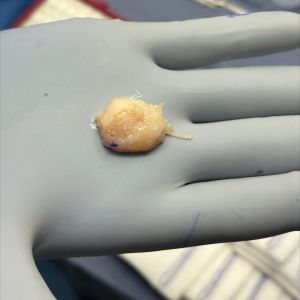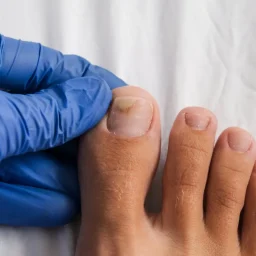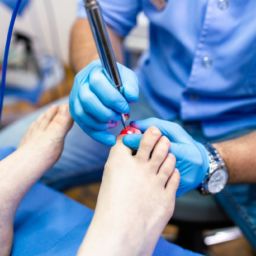
Hallux rigidus, a type of degenerative arthritis affecting the big toe joint, can be a real pain—literally. If you’re between the ages of 30 and 60 and have experienced stiffness or pain in your big toe, you might be dealing with this condition. Hallux rigidus can make everyday activities like walking or even standing feel challenging, but there’s hope.
Managing this condition often starts with nonsteroidal anti-inflammatory drugs (NSAIDs) to reduce pain and inflammation. Additionally, choosing shoes with a roomy toe box can provide the necessary comfort and space for your toe. For those with more advanced hallux rigidus, surgical options like using a plate and screws to stabilize the joint can offer significant relief.
In this blog, we’ll dive deep into the causes, symptoms, and most effective treatments for arthritis in the big toe joint. Whether you’re looking to understand your condition better or seeking practical tips to improve your daily life, we’ve got you covered.
What Are the Common Causes & Symptoms of Arthritis in the Big Toe Joint?
Big toe arthritis, often referred to as hallux rigidus, can stem from various causes. One common culprit is wear and tear over time, which leads to the gradual breakdown of the cartilage in the joint. This damaged cartilage can result from repetitive stress or injuries, making the joint stiff and painful. In some cases, big toe arthritis is linked to rheumatoid arthritis, an autoimmune disorder that attacks the joints, causing inflammation and damage.
Symptoms of big toe arthritis include a stiff big toe that makes it difficult to move or bend. You might notice swelling around the joint, persistent pain, and even the formation of bone spurs, which can exacerbate discomfort. As the condition progresses, walking or standing for long periods can become increasingly challenging.
Understanding the causes and symptoms is the first step in managing big toe arthritis effectively, helping you find the right treatment to maintain mobility and reduce pain.
Is It True that Women are More Prone to Suffer from Big Toe Arthritis?
Women are more prone to arthritis in the big toe, particularly hallux rigidus. This higher prevalence among women can be attributed to several factors:
1. Footwear Choices: Women often wear high-heeled or narrow-toed shoes, which can increase stress on the big toe joint and lead to arthritis over time.
2. Hormonal Factors: Hormonal differences, particularly related to estrogen, can influence joint health and may contribute to the development of arthritis.
3. Foot Anatomy: Women’s feet tend to have different structural characteristics compared to men’s, which can affect the biomechanics of the foot and increase the likelihood of developing arthritis in the big toe.
These factors combined make women more susceptible to developing arthritis in the big toe joint compared to men*
Let’s talk about treatment options for big toe arthritis
When it comes to treating big toe arthritis, there are several treatment options to consider, both surgical and non-surgical, to help relieve pain and improve range of motion.
Non-surgical treatments
For those in the early stages of big toe arthritis, non-surgical treatments can be quite effective. Nonsteroidal anti-inflammatory drugs (NSAIDs) are commonly prescribed to reduce pain and inflammation in the metatarsophalangeal joint. Additionally, physical therapy exercises can help maintain and even improve the range of motion in your toe. Wearing shoes with a wide toe box and stiff sole can also alleviate discomfort by reducing pressure on the joint. Custom orthotic inserts can provide added support and distribute weight more evenly across your foot.
Surgical Treatments
When non-surgical methods fail to provide adequate relief, surgical options may be necessary. One common procedure is cheilectomy, which involves removing large bone spurs that restrict movement and cause pain. In more severe cases, joint replacement surgery might be the best option. This procedure involves replacing the damaged metatarsophalangeal joint with an artificial implant, significantly improving mobility and relieving pain. Another surgical option is arthrodesis, where the bones in the big toe joint are fused together to eliminate pain, although this sacrifices some range of motion.
Whether opting for non-surgical treatments or considering surgery, it’s essential to consult with a healthcare professional to determine the best course of action for your specific condition.


Post Surgery - Arthritic tissue removal
How Can a Podiatrist Assist You with Your Condition?
Seeing a podiatrist for big toe arthritis can be a crucial step in managing the condition and improving your quality of life. Podiatrists specialize in diagnosing and treating foot and ankle problems, including arthritis in the big toe joint (hallux rigidus). Here’s what you can expect when you visit a podiatrist for this condition:
1. Diagnosis: Your podiatrist will start by conducting a thorough examination of your foot, focusing on the affected big toe joint. They may ask about your symptoms, medical history, and any factors that aggravate or alleviate your pain.
2. Diagnostic Tests: Depending on your symptoms and physical examination, your podiatrist may order X-rays or other imaging tests to assess the severity of arthritis, look for bone spurs, and evaluate joint damage.
3. Treatment Options: Based on the diagnosis, your podiatrist will discuss various treatment options tailored to your condition. These may include:
– Medications: Prescribing nonsteroidal anti-inflammatory drugs (NSAIDs) to reduce pain and inflammation.
– Orthotics: Recommending custom orthotic inserts to support the foot and relieve pressure on the affected joint.
– Physical Therapy: Suggesting exercises to improve joint flexibility and strengthen surrounding muscles.
– Injections: Offering corticosteroid injections for temporary pain relief.
– Surgical Consultation: Referring you to an orthopedic surgeon if surgical intervention, such as joint replacement or fusion, is necessary.
4. Footwear Advice: Providing guidance on appropriate footwear choices to minimize discomfort and prevent further joint damage.
Visiting a podiatrist ensures you receive personalized care and comprehensive treatment options to manage big toe arthritis effectively. It’s important to seek professional advice early to prevent progression of the condition and maintain optimal foot health.
Make an Appointment with Experts at Certified Foot and Ankle Specialists
Dealing with the discomfort of big toe arthritis? It’s time to visit the podiatry experts at Certified Foot and Ankle Specialists. Our team is dedicated to tackling a variety of foot conditions, including troublesome arthritis in the big toe joint. We’re committed to providing personalized care that meets your unique needs. Using cutting-edge diagnostic tools like the PedCat and innovative treatments, we pinpoint the problem and offer effective solutions tailored just for you.
Ready to step toward relief? Schedule your appointment today by clicking the link below or calling us at (855) 550-3338. Let’s get you back on your feet comfortably and confidently! If you are searching for a ‘podiatrist in Brandon‘ look no further as have multiple locations in the Tampa region. We also have locations in Fort Myers, West Palm Beach, Boynton Beach and more.
Sources:
1. American Orthopaedic Foot & Ankle Society. (2020). Hallux Rigidus. Retrieved from http://www.aofas.org/
2. Journal of Foot and Ankle Research. (2008). Prevalence and Impact of Hallux Rigidus. Retrieved from
Gilheany, M.F., Landorf, K.B. & Robinson, P. Hallux valgus and hallux rigidus: a comparison of impact on health-related quality of life in patients presenting to foot surgeons in Australia. J Foot Ankle Res 1, 14 (2008). https://doi.org/10.1186/1757-1146-1-14




